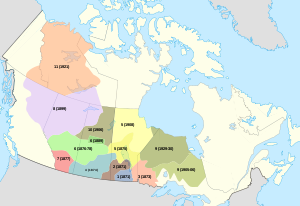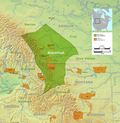
The Blackfoot Confederacy, Niitsitapi, or Siksikaitsitapi, is a historic collective name for linguistically related groups that make up the Blackfoot or Blackfeet people: the Siksika ("Blackfoot"), the Kainai or Blood, and two sections of the Peigan or Piikani – the Northern Piikani (Aapátohsipikáni) and the Southern Piikani. Broader definitions include groups such as the Tsúùtínà (Sarcee) and A'aninin who spoke quite different languages but allied with or joined the Blackfoot Confederacy.
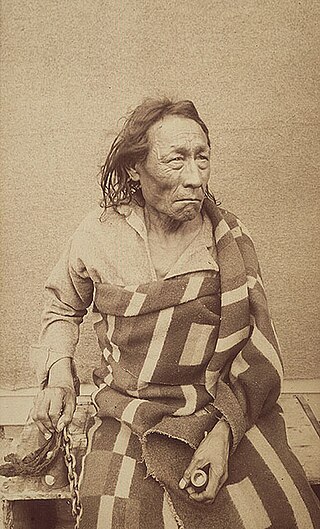
Big Bear, also known as Mistahi-maskwa, was a powerful and popular Cree chief who played many pivotal roles in Canadian history. He was appointed to chief of his band at the age of 40 upon the death of his father, Black Powder, under his father's harmonious and inclusive rule which directly impacted his own leadership. Big Bear is most notable for his involvement in Treaty 6 and the 1885 North-West Rebellion; he was one of the few chief leaders who objected to the signing of the treaty with the Canadian government. He felt that signing the treaty would ultimately have devastating effects on his nation as well as other Indigenous nations. This included losing the free nomadic lifestyle that his nation and others were accustomed to. Big Bear also took part in one of the last major battles between the Cree and the Blackfoot nations. He was one of the leaders to lead his people in the last, largest battle on the Canadian Plains.

Pîhtokahanapiwiyin, also known as Poundmaker, was a Plains Cree chief known as a peacemaker and defender of his people, the Poundmaker Cree Nation. His name denotes his special craft at leading buffalo into buffalo pounds (enclosures) for harvest.
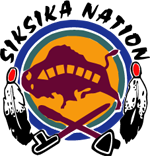
The Siksika Nation is a First Nation in southern Alberta, Canada. The name Siksiká comes from the Blackfoot words sik (black) and iká (foot), with a connector s between the two words. The plural form of Siksiká is Siksikáwa. The Siksikáwa are the northernmost of the Niitsítapi, all of whom speak dialects of Blackfoot, an Algonquian language.

Crowfoot or Isapo-Muxika was a chief of the Siksika. His father, Istowun-ehʼpata, and mother, Axkahp-say-pi, were Kainai. He was five years old when Istowun-ehʼpata was killed during a raid on the Crow tribe, and, a year later, his mother remarried to Akay-nehka-simi of the Siksika people among whom he was brought up. Crowfoot was a warrior who fought in as many as nineteen battles and sustained many injuries, but he tried to obtain peace instead of warfare. Crowfoot is well known for his involvement in Treaty Number 7 and did much negotiating for his people. While many believe Chief Crowfoot had no part in the North-West Rebellion, he did in fact participate to an extent due to his son's connection to the conflict. Crowfoot died of tuberculosis at Blackfoot Crossing on April 25, 1890. Eight hundred of his tribe attended his funeral, along with government dignitaries. In 2008, Chief Crowfoot was inducted into the North America Railway Hall of Fame where he was recognized for his contributions to the railway industry. Crowfoot is well known for his contributions to the Blackfoot nation, and has many memorials to signify his accomplishments.
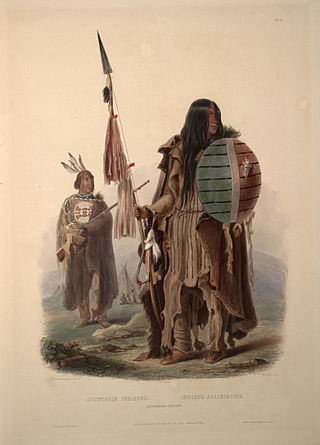
The Assiniboine or Assiniboin people, also known as the Hohe and known by the endonym Nakota, are a First Nations/Native American people originally from the Northern Great Plains of North America.

The Tsuutʼina Nation, also spelled Tsuu Tʼina or Tsu Tʼina, is a First Nation band government in Alberta, Canada. The Tsuu T'ina Nation 145 reserve is located directly west of Calgary, with its eastern edge directly adjacent to the southwest city limits. Their traditional territory spans a much larger area in southern Alberta. The land area of the current reserve is 283.14 km2, and it had a population of 1,982 in the 2001 Canadian census. The northeast portion of the reserve was used as part of CFB Calgary, a Canadian Army base, from 1910 to 1998. In 2006, the land was returned to the Nation by the Government of Canada.
First Nations in Alberta are a group of people who live in the Canadian province of Alberta. The First Nations are peoples recognized as Indigenous peoples or Plains Indians in Canada excluding the Inuit and the Métis. According to the 2011 Census, a population of 116,670 Albertans self-identified as First Nations. Specifically there were 96,730 First Nations people with registered Indian Status and 19,945 First Nations people without registered Indian Status. Alberta has the third largest First Nations population among the provinces and territories. From this total population, 47.3% of the population lives on an Indian reserve and the other 52.7% live in urban centres. According to the 2011 Census, the First Nations population in Edmonton totalled at 31,780, which is the second highest for any city in Canada. The First Nations population in Calgary, in reference to the 2011 Census, totalled at 17,040. There are 48 First Nations or "bands" in Alberta, belonging to nine different ethnic groups or "tribes" based on their ancestral languages.
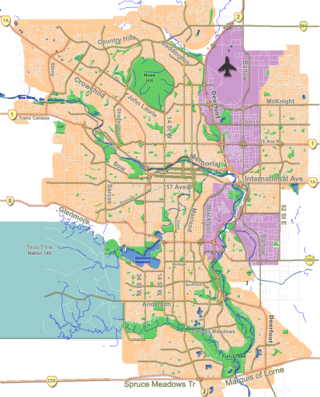
Tsuu T'ina Nation 145 is an Indian reserve of the Tsuut'ina Nation in southern Alberta, Canada, created by Treaty 7.

David Laird, was a Canadian politician. He was born in New Glasgow, Prince Edward Island, into a Presbyterian family noted for its civic activism. His father Alexander had been a long time Reformer and Liberal MLA. David became a Liberal MLA for Belfast. He also established and edited The Patriot.
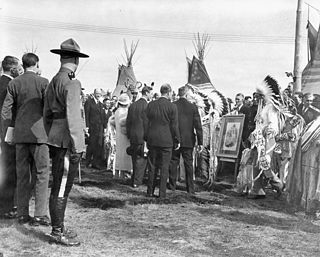
The Nakoda are an Indigenous people in Western Canada and the United States.

Stoney 142, 143, 144 is an Indian reserve of the Stoney Nakoda First Nation, comprising Bearspaw, Chiniki, and Wesley First Nations in Alberta, located between the Municipal District of Bighorn No. 8 and Rocky View County. The largest community of the Nakoda people, it is 56 kilometers west of Calgary.

Treaty 4 is a treaty established between Queen Victoria and the Cree and Saulteaux First Nation band governments. The area covered by Treaty 4 represents most of current day southern Saskatchewan, plus small portions of what are today western Manitoba and southeastern Alberta. This treaty is also called the Qu'Appelle Treaty, as its first signings were conducted at Fort Qu'Appelle, North-West Territories, on 15 September 1874. Additional signings or adhesions continued until September 1877. This treaty is the only indigenous treaty in Canada that has a corresponding indigenous interpretation.

The Fort Belknap Indian Reservation is shared by two Native American tribes, the A'aninin and the Nakoda (Assiniboine). The reservation covers 1,014 sq mi (2,630 km2), and is located in north-central Montana. The total area includes the main portion of their homeland and off-reservation trust land. The tribes reported 2,851 enrolled members in 2010. The capital and largest community is Fort Belknap Agency, at the reservation's north end, just south of the city of Harlem, Montana, across the Milk River.
The Alexis Nakota Sioux Nation no. 437 is a Nakoda First Nation which reserves near Edmonton, Hinton, and Whitecourt, in the Canadian province of Alberta, and headquartered at 54° N and 114°, about 85 kilometres (53 mi) west of Edmonton. The Alexis Nakota Sioux Nation is a member of Treaty 6.
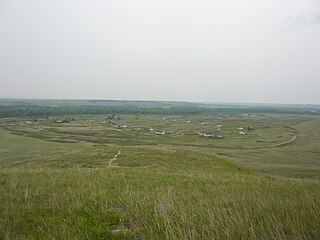
Blackfoot Crossing Historical Park is a complex of historic sites on the Siksika 146 Indian reserve in Alberta, Canada. This crossing of the Bow River was traditionally a bison-hunting and gathering place for the Siksika people and their allies in the Blackfoot Confederacy.
The Iron Confederacy or Iron Confederation was a political and military alliance of Plains Indians of what is now Western Canada and the northern United States. This confederacy included various individual bands that formed political, hunting and military alliances in defense against common enemies. The ethnic groups that made up the Confederacy were the branches of the Cree that moved onto the Great Plains around 1740, the Saulteaux, the Nakoda or Stoney people also called Pwat or Assiniboine, and the Métis and Haudenosaunee. The Confederacy rose to predominance on the northern Plains during the height of the North American fur trade when they operated as middlemen controlling the flow of European goods, particularly guns and ammunition, to other Indigenous nations, and the flow of furs to the Hudson's Bay Company (HBC) and North West Company (NWC) trading posts. Its peoples later also played a major part in the bison (buffalo) hunt, and the pemmican trade. The decline of the fur trade and the collapse of the bison herds sapped the power of the Confederacy after the 1860s, and it could no longer act as a barrier to U.S. and Canadian expansion.

Carry the Kettle Nakoda Nation is a Nakota (Assiniboine) First Nation in Canada located about 80 km (50 mi) east of Regina, Saskatchewan and 13 km (8.1 mi) south of Sintaluta. The reservation is in Treaty 4 territory.
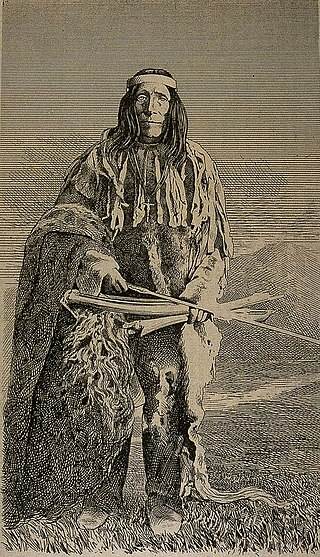
Sweet Grass was a chief of the Cree in the 1860s and 1870s in western Canada. He worked with other chiefs and bands to participate in raids with enemy tribes. While a chief, Sweet Grass noticed the starvation and economic hardship the Cree were facing. This propelled him to work with the Canadian and eventually sign Treaty Six. Sweet Grass believed that working alongside the government was one of the only solutions to the daily hardship the Cree were faced with. The Sweet Grass Reserve west of Battleford, Saskatchewan was named in his honor and is still functioning today.
